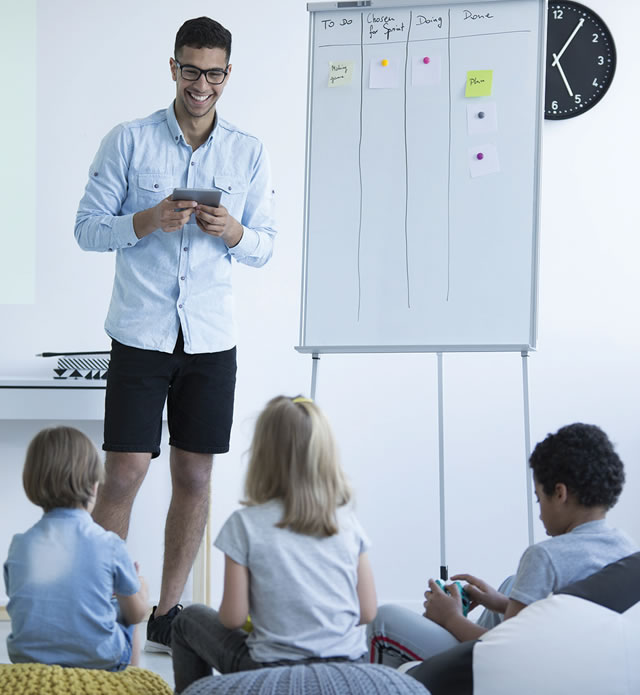The "Human" in Human-Centered, Evidence-Based Design for Education
- By Jonathan Matta
- 05/01/21
A picture is worth a thousand words. It’s a
moment in time that its creator tries to capture as accurately
as possible. The problem is that viewers naturally craft a
counterfeit. What do I mean by that?
Close your eyes, and imagine a photo of an active learning
environment. What do you see? Flexibility? Yes. Digital and
analog tools? Maybe. Mechanical tools? Sometimes. Buzzwords
on writeable surfaces? You bet! Students are learning,
and teachers are teaching. All is right!

PHOTO CREDIT PHOTOGRAPHEE.EU
Now, look more closely at the photo. Do you really know
what’s going on? While the photo tells a story about learning,
personal stories are also captured. Somewhere in that
photo is the “why” behind the personal interactions and the
physical space.
Why is one student seated at a desk using paper and
pencil while another is standing at a table, swiping away on
an iPad?
You notice groupings of desks, cubbies for storage and
chairs stacked in the background. How will the furniture be
used to achieve the teacher’s goals?
The personal stories inform the larger picture, but they
all too often are lost. The photo becomes one of the thousands
of images we see daily. Our eyes deceive us, leading to
a “me too” moment: “I’ve been there, seen that. I know what’s
going on in that learning space, and I want the same thing.”
What does human-centered, evidencebased
design for schools mean?
This situation demonstrates the importance of human-centered
design in education when creating solutions, products and
services.
A human-centered design process simply means that we
design for the humans who will use the solution. A process
developed by Stanford’s Hasso Plattner Institute of Design,
better known as the d.school, it posits that design is not based
on our “me too” inclinations or preconceived notions of what
makes an effective learning environment. Human-centered
design identifies the “why” and establishes the foundation for
authentic creation.
The impact of furniture within the
classroom
What is “authentic creation”? Innovation and change are driven by
understanding how and why people will use a design solution –
evidence, if you will. Authentic creation leads to real change
much faster than a “me too” strategy. That’s the end game.
A recent study (Ruckus Grant Program, developed and executed by KI in 2017-2018) examined the impact of furniture on
teaching and learning. Nine schools and universities across the
country agreed to participate. Through a survey, information was gathered on pedagogies and current
classroom configurations to establish a
baseline. Teachers and students rated the
following statements:
- Move “however I want”
- Work comfortably with technology
- Work in groups
- Engagement/participation
- Enjoyment/retention
After teaching and learning in their
existing classrooms for six months, each
institution was provided with furniture
to create an adaptive, human-centered
learning environment. No other
variables (such as flooring, lighting or
technology) changed. After isolating
furniture as a variable, participants were
surveyed again to gauge the level of
impact on the learning experience.
The results showed increases between
30% and 60% within each area. That's
an incredible impact, and the results
heavily support the efficacy of furniture
to drive positive change within a learning
culture.
Where do designers and educators
start, and what is the process?
Start with empathy, and ask to
observe a learning environment in action.
Firsthand observations of education
goals bring perspective, removing
ideas generated by “me too” tendencies. Collecting qualitative data about behavior
helps uncover design drivers that make
human-centered design possible.
One of my favorite empathy exercises
is the “backpack of the future” exercise.
Pass out the notecard above to students
when you're reimagining learning
spaces. An open question allows you to
receive feedback on likes, wishes, wants
and needs.
The exercise imposes no limitations
on student mindsets. It allows for the
flow of curious, uninhibited thoughts.
After finishing the exercise, gather
everyone’s “ingredients” and group them
into common themes, synthesizing the
information so commonalities and differences
easily surface.
Synthesizing the information is
usually the most difficult part of the
human-centered design process. I recommend
you approach this process with
a team of trusted experts. The insights
and outcomes require more than a single
perspective.
Below is a photo of a workshop where
a wall of ideas was created through a
similar exercise: single ideas grouped
together by large, common themes. The
results revealed design drivers rooted in
empathy.
Once design drivers are identified,
move on to physical space. For example,
if technology integration surfaces as a
need, maybe a makerspace would be of
benefit. Review what furniture solutions
would make for a successful space.
Finally, prototype and create a physical
learning environment that embodies
the design drivers captured in the
human-centered design process. You’ll
discover the importance of each driver,
establishing the tools and products needed
to make that vision come to life.
The human-centered, evidence-based
design process is fundamentally simple,
but it can be difficult to dive deep into
human behavior, organizational implications
and cultural limitations. The work
is intense, but the end result leads to
“we are” instead of “me too.”
About the Author
Jonathan Matta is KIs National Education Leader, supporting organizations in their pursuit of solving complex challenges by applying the power of design.